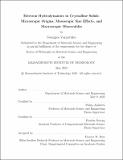| dc.description.abstract | Despite the continued scaling down of transistors since the invention of the integrated circuit over seventy years ago, recent trends have deviated from Moore’s predictions, due to fundamental physical limitations including heat dissipation. With data centres already using an estimated 200 terawatt hours each year, and projected to make up as high as 8% of global demand by 2030, there is a pressing need to design energy-efficient nanoelectronics using bottom-up techniques. As high-quality single-crystal materials used in nanoelectronic devices approach the micro- and nano-scale, the transport of heat and charge in these devices results in inhomogeneous spatial signatures, which must be understood through spatially-resolved transport theories.
One particularly-exciting example of emergent transport phenomena with distinct spatial signatures is the recently re-invigorated field of “electron hydrodynamics”. Advances in spatially-resolved transport measurements have revealed that electrons in condensed matter can flow collectively, exhibiting fluid phenomena such as channel flow and vortices. The observations confirm theoretical predictions over half a century old, violating textbook descriptions which treat electron collisions akin to billiard balls. Unlike everyday fluids however, preferred directions in crystals imply electron fluids exhibit anisotropic and non-dissipative viscous contributions, giving rise to novel electronic transport phenomena. Resistive processes in these hydrodynamic devices occur predominantly at the boundaries, altering the spatial distribution of heat dissipation and thus impacting thermal design.
In this thesis, a multi-scale theoretical and computational framework to understand hydrodynamic phenomena in three-dimensional crystalline solids is presented. Starting from the smallest length-scales, temperature-dependent electron interactions are predicted from first principles at the Eliashberg level of theory. These suggest the indirect lattice-mediated electron interaction dominates in bulk semimetals, including those with topological band crossings. These microscopic interaction lifetimes are used as input to solve the mesoscopic Boltzmann transport equation, with an efficient 3 spatially-resolved solver developed as part of this thesis. Going beyond the limiting relaxation time approximation, the importance of these microscopic details on the linearized scattering matrix is evaluated, resulting in a macroscopic viscosity tensor. The additional complexities these anisotropic and asymmetric viscosity tensors introduce to electron flow is investigated by solving the electronic Navier Stokes equations in experimentally-accessible geometries. Finally recent experimental observations of the non-monotonic temperature-dependence and directional-dependence of electron flow in bulk WTe2 and PdCoO2 respectively are elucidated. The thesis concludes with a discussion on the importance of the presented results in the broader context of the field of electron hydrodynamics and suggests possible future avenues of inquiry. | |
